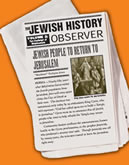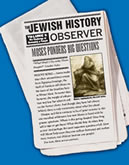- Home
- Play & Learn Home
- Online Enrichment
- Experience Modern Israel
- Israel It's Complicated
- Jewish and Me
- Jewish Holidays Jewish Values
- Jewish Values in Genesis and Jewish Values in Exodus
- Min Ha’aretz
- Our Place in the Universe
- Simply Seder
- The Prophets: Speaking Out for Justice
- Making T'filah Meaningful
- Make, Create, Celebrate
- Yom Haatzmaut Resources
- Hebrew Apps
- About The OLC
- What is the OLC?
- Introduction
- Get Started
- Resources
- OLC Content
- Parent Materials
- See My OLC Classes
- Store
Ways to Use The Jewish History Observer
Techniques to engage students through active learning in the historical periods, events, and figures in The Jewish History Observer.
|
"WOOHOO!" EXCLAIM JEWS So begins The Jewish History Observer 2, in which newspaper-style articles "report" Jewish history as it happens, bringing it to life for 7–9th graders. The above exclamation of joy underscores the headline, "Jewish People to Return to Jerusalem." In the first booklet, students learn about the Jews’ Exodus from Egypt and their entrance into Canaan; the period of judges, prophets, and kings; and the rise and fall of Israel’s Golden Age. In the second, students learn about Jewish life during the Greek and Roman periods; the Judeo-Roman War and later exile; and the development of the Mishnah and Talmud. Two more booklets will follow next year covering the Medieval (400 - 1250 CE) and Pre-Enlightenment Periods (1250 - 1740 CE). Designed to engage your students’ imaginations and intellectual curiosity, The Jewish History Observer will provide your teens with a lasting connection to Jewish history. The following techniques can help bring the historical material to life in your classroom.
|
|
||||||
-
Whole class and groups
-
Introduce The Jewish History Observer 1 into the classroom the same way you might use a current events article in a class on Israel. Point out to the students that like today, in Biblical times politics, culture, war, and sports were everyday hot topics. Explore the material with your class as if this is their local newspaper.
-
Assign articles from each booklet to individual students to read silently, and then have them present the information to the class. For an extra challenge, have students do web-based research on a personality or time period and present three or more additional facts to the class. Recommended web sites include Center for Jewish History at www.cjh.org/ and Jewish Virtual Library at www.jewishvirtuallibrary.org/
-
Assign reading roles to individual students. For example, students may be the:
-
narrator, who reads the historical narrative
-
newscaster, who reads the photo and art captions
-
historian, who explains the historical periods based on the timelines
-
comedian, who reads (and performs) the comic strips in the booklets
-
-
Have students read parts of the booklet as if presenting a newscast. Videotape your students, and then play the "evening news" for younger classes.
-
Choose a student to read a feature aloud. The rest of the class then asks questions of the reader.
-
Present the basic themes of an historical period in the Observer, then brainstorm with the class how these themes are present today. For example, they might examine how Samuel’s reluctance to appoint a king (kings often abuse their power, he believed) is reflected in tyrannies today.
-
Play "Twenty Questions." Have one student select a figure from the text. Give the rest of the class twenty questions to find out who the character is. Only Yes/No questions are allowed.
-
Invite students to stand in a circle. Have them toss a beanbag or soft ball to one another. As each student catches the ball, he or she should complete the sentence, "One thing I didn’t know is that…" by stating one fact from the lesson. (Technique taken from Challenge and Change 3 Teaching Guide, page 21).
-
Whip around the classroom quickly, calling on students to say something they learned about Jewish life from the era you are studying.
-
-
Pairs
-
Have students individually complete the "You’re the Reporter" activity on the back page of each booklet. Or divide students into pairs (or have them choose a partner) and complete the activity together. Have the partners interview one another and fill in each other’s lines. Ask for volunteers to read their responses.
-
Ask each student to select a historical figure from the booklets, then have his or her partner conduct an interview as a television talk show host. For example, a student might choose to be Alexander the Great; the partner would ask questions such as, "What was your real name?" "Tell me how far your empire stretched?" "Is it true that you bowed to Jaddua, the Jewish High Priest of Jerusalem?" Have pairs present the result of their interviews to the class.
-
Have students construct a Jeopardy-style game where one member of the pair writes a name, place, or historical fact (the answer), and the other member asks the appropriate question.
-
Upon completion of a booklet, ask students to work with a partner to decide which character or event had the greatest influence on the historical period. Students should be prepared to substantiate their answers.
-
-
Individuals
-
Assign students an article, or have students select their own, and have them write a newspaper op-ed piece based on the article. Consider posting their work on a history bulletin board.
-
Give each student a post-it note on which to write the name of a figure from the chapter or from independent study who made an impression on them. Have students affix the notes to their shirts and walk around the room discussing with one another the person they chose and the reasons for their choice. Invite volunteers to share with the class what they learned from their conversation. (Technique taken from Challenge and Change 3 Teaching Guide, p. 13)
-
Write historical facts about the time period on the chalkboard and have students write their own article for the Observer. Add the articles to your history bulletin board.
-
Have students write or draw their own cartoons based on the information they have learned. They can use "Sam Seltzer, On Assignment" as a model.
-
By using techniques such as these, you can help students make their own meaning of the historical information and actively engage them in learning. Enjoy your journey back in time!



